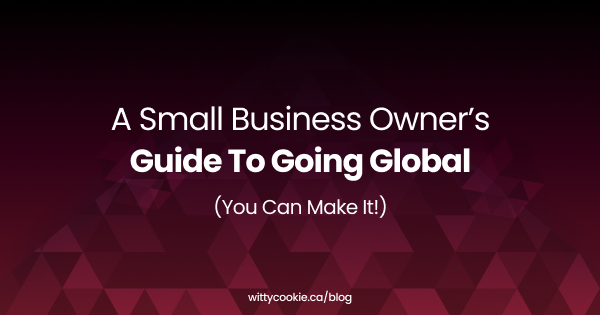A Small Business Owner’s Guide To Going Global (You Can Make It!)
Most small business owners are eager to grow their brands and increase their market shares within local regional markets. However, those who look further afield can find strong opportunities to create a global small business that thrives across borders.
Creating the conditions for international small business growth is no easy feat. It takes a robust global marketing approach, careful research and planning, and the sourcing of reliable international shipping options. If you take the right approaches, creating a global business can bring you a whole host of benefits, including a more diverse range of revenue streams and opportunities for expansion into new markets.
With that said, it takes time, money and resources to create a global small business that can withstand challenges across markets and borders. Here’s what you should know about taking your small business global, and best practices to ensure your ongoing success in international markets.
The Challenges of Starting a Global Business
Some business owners only find out about challenges like currency fluctuations, communication obstacles, and tax compliance issues once they have already branched into new markets. It’s crucial to know about the most common challenges of establishing a global business before you go ahead with your expansion strategy. This will help prevent you from encountering the same challenges yourself.
These are some of the challenges to be aware of:
- Failing to create a plan of action. Small businesses are especially vulnerable to a lack of planning. But many larger businesses fall prey to this common mistake, too. It takes far more time and resources to correct problems created by a lack of planning than it would to work according to a strategy and avoid these issues entirely.
- Chasing too many opportunities. It may seem very promising that many different markets and regions are interested in your products. But chasing all of these opportunities at once can stretch your small business resources thin. It requires patience, research and discipline to choose the regions that are most likely to positively impact your sales funnels and launch your business to international success.
- Marketing exclusively in English. Many regions and target audiences operate in English, but just as many prefer regional languages. Familiarize yourself with these languages. Then, hire native copywriters and marketers to help you translate your brand messages in a way that will resonate with your audience rather than alienate them.
- Assuming that certain local strategies will work for other regions. Strategies that work in your home region may not be effective elsewhere in the world. So, it’s vital to tailor your global marketing strategies to each country you branch into. Remember to take cultural and marketplace differences into account, along with differences in pricing, shipping and packaging norms.
Research Prospective Markets
Research is the key to success when it comes to building a global business. Even the largest corporations can fail to successfully expand into new markets if they don’t do their homework before launching their expansions. You need to research the local culture of your prospective markets carefully. Take care to understand how these factors play into your own industry, the size and preferences of your target market.
A good idea is to perform a gap analysis, SWOT analysis, and a market segmentation analysis. You can also work closely with professionals who are native to your target locations to gain a deep understanding of the market and its current state. You may need to adjust your global marketing strategies according to local and regional cultures, preferences and methodologies that have already been proven effective. The only way to achieve this is to gain significant insights into the markets you plan on entering. Then, use that data to set immediate and long term goals and metrics for success.
Establish an Online Presence
Any global small business needs a strong online presence as the foundation of its global marketing strategies. Traditionally, most small businesses would start locally and then expand from there. But the internet has facilitated a shift towards many businesses starting online from the get-go.
eCommerce stores, small business websites, and online marketplaces are essential in a business’ pursuit to go global. These can all be established easily using a variety of tools, including website builders like Shopify, Etsy and WordPress.
Expand Across Multiple Channels
Casting your net wide is another effective strategy to expand the reach of your small business. You can create a digital store on your brand’s website by adding a lot of different marketplaces to your portfolio to broaden your reach online.
Use Social Media Marketing to Your Advantage
Using social media platforms is a fantastic way to take your venture international while creating more brand recognition in new markets.
Social media platforms like Instagram, Facebook and TikTok have built-in algorithms and features designed to help entrepreneurs grow their small businesses at both local and international scales. Add links to your company website on your social media channels to drive even more traffic toward your core sales channels.
Hot Tip!
Take your social media marketing to the next level! WittyCookie, will take your brand into their heart, study your business, evaluate your latest social media marketing strategy, and craft a seamless action plan perfectly tailored for you!
WittyCookie can amplify your social media reach, learn more here.
Examine Your Pricing Strategies
One of the biggest challenges business owners face when trying to build a global small business is fierce price competition and free shipping from larger, local enterprises. Do some research and allow for some flexibility in your pricing strategies to remain competitive in foreign markets.
It’s important to assess whether or not free international shipping for small businesses is a part of your competitors’ pricing models. Adjust your prices accordingly to make sure that you can compete with success.
Evaluate Ways to Distribute Your Products Internationally
Your global business plan should include your methods and strategies for distributing your products and services abroad. You can choose from a range of product distribution methods, from opening foreign subsidiaries and working with distributors and agents to setting up a regional eCommerce store.
Use an MVP to Expand Slowly into New Markets
You should aim to enter new markets with an attractive, compelling and functional minimum viable product (MVP) to take your small business global. An MVP is a version of a product with just enough features to be usable by early customers. You can expand your offerings and how you operate in certain regions based on the feedback you receive from your initial launch and your MVP.
The key is to listen to your target audiences’ feedback. Use that data to act proactively in a way that best meets their needs and expectations. If you choose to enter and grow in new markets slowly and strategically, you can lower your risk and improve your chances of ongoing success.
Create a Great Returns Policy
You need to develop a strong returns policy as part of your broader international shipping for small business plans. Many smaller companies fail to focus on their returns policies, and their businesses suffer as a result. Post your clear returns policy online so that your buyers know exactly what to expect if and when they wish to return products to you.
It’s recommended that you seek out tools that help you streamline the returns process and make it easier both for your business and your customers. Your returns process should enhance the customer journey and experience through pre-selected options and quick, fuss-free returns.
Remain Compliant in Non-Local Regions
Tax codes and compliance laws vary widely from state to state and country to country. You’ll need to research and understand the regulations of the areas in which you wish to operate before you take your small business global. Bear in mind that you may need certain licenses and permits to ship products to certain regions.
Build Local Relations
Small business owners can learn a lot of what they need to know about foreign markets online. However, having local business contacts in your regions of operation can go a long way in tailoring targeted global marketing strategies for your audiences.
Get in touch with local business associations, freelancers and influencers. This will help you learn as much insider information as you can and gain a deep understanding of the nature of business in new locations.
Expand Logically and Strategically
Many global small business owners started their global journeys with a single step into a new, nearby regional market. For instance, many small businesses in the US expand into Canada or Mexico first, before exploring their opportunities on new continents.
Consider the Infrastructure in Your Target Markets
The infrastructure in different countries and regions can vary widely. It’s important to consider this in your overall strategy when looking to go global.
What is the infrastructure like in your target destinations? Can you source the support and accommodations you need to expand successfully into those markets? How is the electricity supply and road infrastructure, and how can you navigate challenges in these regards?
Considerations like these must be made to ensure that your international shipping strategy suits the markets in which you plan to operate.
Determine If Your Target Audience is Familiar with Your Products
If your target market in a certain region isn’t familiar with the nature of your products and services, you may need to invest a significant amount of time and money into consumer education. However, if you can successfully introduce a novel concept to a region, that product may become synonymous with your brand. In turn, this will help you secure a significant share of the market.
Be Ready – Legally, Financially and Organizationally
Being ready means that you are prepared to navigate a new region’s legal, cultural, financial and tax nuances. At an organizational level, you must make sure that you’re ready to sell in new regions. Develop benefits programs and compensation schemes that are aligned with local standards and expectations, along with procedures and policies that meet the new region’s needs. At the same time, you must represent your small business’ culture and what makes it unique.
Financial and legal preparation includes research into more litigious markets and economies, as well as preparing documents in numerous languages. Most accounting, tax and payroll procedures should be outsourced to regional parties if possible to avoid your core business becoming overwhelmed.
Seek Out Help and Resources
Creating a global small business can be challenging and daunting. Luckily, assistance is at hand for small businesses that are aiming to go international. Organizations like the Small Business Administration offer portals through which you can seek guidance from experienced small business counselors.
The Takeaway
Creating a thriving global small business carries risks and challenges, but it also provides opportunities for large-scale success and exponential growth. Plan your expansion strategies carefully, take each expansion process slowly, and be sure to plan for every contingency to protect your investments.



